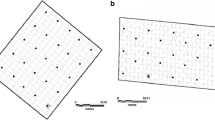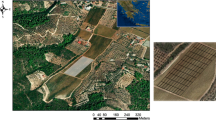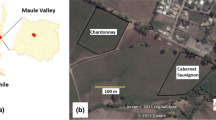Abstract
The aim of this study was to assess the spatial variability of plant vigor in a vineyard in a humid climate. Normalised Difference Vegetation Index (NDVI) was used for relating the vigor level to grapevine performance and, as a new area, with the anthocyanin and organic acid compositions of the berries. The study was performed in a rain-fed vineyard with the Tannat cultivar, vertically trellised, during three consecutive vintages (2015–2017). NDVI was estimated from high-resolution images acquired using airborne sensors, which allowed differentiation of three vigor levels within the vineyard: high, medium and low. Three plots per vigor level were installed for performing samplings and field measurements. High vigor zones were associated with less water-stressed vines, higher yields, incidence of bunch rot, larger berries, total acidities and total anthocyanins concentrations. Low vigor zones corresponded to higher pH, soluble solids and phenolic contents in the berries. Medium vigor zones were associated with higher leaf surface, pruning weights, cluster average weights and greater extractable anthocyanins concentrations. The effect of weather conditions of each growing season on grapevine water status was a major factor influencing the analysed variables. NDVI values allowed for delineating areas with homogeneous vigor within the vineyard, which corresponded with different plant performance, showing the usefulness of this tool for site-specific management under the studied conditions.



Similar content being viewed by others
Explore related subjects
Discover the latest articles and news from researchers in related subjects, suggested using machine learning.References
Acevedo-Opazo, C., Tisseyre, B., Guillaume, S., & Ojeda, H. (2008). The potential of high spatial resolution information to define within-vineyard zones related to vine water status. Precision Agriculture,9, 285–302.
Alliaume, F., González Barrios, P., Echeverría, G., Ferrer, M. (2017). Characterization of spatial variability of soils within a vineyard for management zones determination. In XXth GIESCO (Group of International Experts for Cooperation on Vitivinicultural Systems) international meeting proceedings, Mendoza, Argentina (pp. 787–791).
Arnó, J., Martínez-Casasnovas, J. A., Ribes-Dasi, M., & Rosell, J. R. (2009). Review. Precision viticulture: Research topics, challenges, and opportunities in site-specific vineyard management. Spanish Journal of Agricultural Research,7, 779–790.
Baluja, J., Tardáguila, J., Ayestarán, B., & Diago, M. P. (2013). Spatial variability of grape composition in a Tempranillo (Vitis vinifera L.) vineyard over a 3-year survey. Precision Agriculture,14, 40–58.
Bonilla, I., Martínez de Toda, F., & Martínez-Casasnovas, J. A. (2015). Vine vigor, yield and grape quality assessment by airborne remote sensing over three years: Analysis of unexpected relationships in cv. Tempranillo. Spanish Journal of Agricultural Research,13(2), e0903. https://doi.org/10.5424/sjar/2015132-7809.
Bramley, R. G. V. (2005). Understanding variability in winegrape production systems. 2. Within vineyard variation in quality over several vintages. Australian Journal of Grape and Wine Research,11, 33–42.
Bramley, R. G. V. (2010). Precision viticulture: Managing vineyard variability for improved quality outcomes. In A. G. Reynolds (Ed.), Managing wine quality (Vol. 1, pp. 445–480). Cambridge, UK: Woodhead Publishing.
Bramley, R. G. V., Ouzman, J., & Boss, P. K. (2011). Variation in vine vigor, grape yield and vineyard soils and topography as indicators of variation in the chemical composition of grapes, wine and wine sensory attributes. Australian Journal of Grape and Wine Research,17, 217–229.
Calonnec, A., Burie, J.-B., & Langlais, M. (2013). Impacts of plant growth and architecture on pathogen processes and their consequences for epidemic behaviour. European Journal of Plant Pathology,135(3), 479–497.
Carbonneau, A. (1995). La surface foliaire exposée. Guide pour sa mesure (Exposed leaf area. Guide for its measurement). Le Progrès Agricole et Viticole,112(2), 204–212.
Chorti, E., Guidoni, S., Ferrandino, A., & Novello, V. (2010). Effect of different cluster sunlight exposure levels on ripening and anthocyanin accumulation in Nebbiolo grapes. American Journal of Enology and Viticulture,61, 23–30.
Coombe, B. G. (1995). Adoption of a system for identifying grapevine growth stages. Australian Journal of Grape and Wine Research,1, 100–110.
Cortell, J. M., Halbleib, M., Gallagher, A. V., Righetti, T. L., & Kennedy, J. A. (2007). Influence of vine vigor on grape (Vitis vinifera L. cv. Pinot Noir) anthocyanins. 1. Anthocyanin concentration and composition in fruit. Journal of Agricultural and Food Chemistry,55, 6575–6584.
Costa, E., Cosme, F., Jordão, A. M., & Mendes-Faia, A. (2014). Anthocyanin profile and antioxidant activty from 24 grape varieties cultivated in two Portuguese wine regions. Journal International des Sciences de la Vigne et du Vin,48(1), 51–62.
Deloire, A., Carbonneau, A., Wang, Z., & Ojeda, H. (2004). Vine and water, a short review. Journal International des Sciences de la Vigne et du Vin,38(1), 1–13.
Dobrowski, S. Z., Ustin, S. L., & Wolpert, J. A. (2003). Grapevine dormant pruning weight prediction using remotely sensed data. Australian Journal Grape and Wine Research,9, 177–182.
Echeverría, G., Ferrer, M., & Mirás-Avalos, J. M. (2017). Quantifying the relative impact of physical and human factors on the viticultural expression of terroir. International Journal of Environmental & Agriculture Research,3(4), 12–25.
Fermaud, M., Valdés-Gómez, H., Calonnec, A., Roudet, J., Gary, C. (2008). A multivariate analysis of combined effects of (micro) climate, vegetative and reproductive growth on grey mould incidence in grapevine. In G. C. Lozzia, A. Lucchi, S. R. Di Chiara, H. Tsolakis (Eds.), Integrated protection in viticulture, IOBC/wprs bulletin (Vol. 36, pp. 91–94). Retrieved May 10, 2018, from https://www.iobc-wprs.org/members/shop_en.cfm?mod_Shop_detail_produkte=81.
Ferrer, M., Echeverría, G., & Mirás-Avalos, J. M. (2017). Meteorological conditions: Influence on yield, sanitary status and grape composition. International Journal of Environmental & Agriculture Research,3(8), 16–27.
Filippetti, I., Allegro, G., Valentín, G., Pastore, C. H., Colucci, E., & Intrieri, C. (2013). Influence of vigour on vine performance and berry composition of cv. Sangiovese (Vitis vinifera L.). Journal International des Sciences de la Vigne et du Vin,47(1), 21–33.
Fiorillo, E., Crisci, A., De Filippis, T., Di Genaro, S. F., Di Blasi, S., Matese, A., et al. (2012). Airborne high-resolution images for grape classification, changes in correlation between technological and late maturity in a Sangiovese vineyard in Central Italy. Australian Journal of Grape and Wine Research,18, 80–90.
Fischer, A. (1994). A simple model for the temporal variations of NDVI at regional scale over agricultural countries. Validation with ground radiometric measurement. International Journal of Remote Sensing,15, 1421–1446.
García-Estévez, I., Quijada-Morín, N., Rivas-Gonzalo, J., Martínez-Fernández, J., Sánchez, N., Herrero-Jiménez, C., et al. (2017). Relationship between hyperspectral indices, agronomic parameters and phenolic composition of Vitis vinifera cv. Tempranillo grapes. Journal of the Science of Food and Agriculture,97, 4066–4074.
Glories, Y., Augustin, M. (1993). Maturité phénolique du raisin, conséquences technologiques: application aux millésimes 1991 et 1992 (Phenolic maturity of grapes, technological consequences: Application to 1991 and 1992 vintages). In Proceedings of the journée technique. CIVB, Bordeaux, France (pp. 56–61).
González-Neves, G., Barreiro, L., Gil, G., Franco, J., Ferrer, M., Carbonneau, A., et al. (2004a). Anthocyanic composition of Tannat grapes from the South region of Uruguay. Analytica Chimica Acta,513(1), 197–202.
González-Neves, G., Charamelo, D., Balado, J., Barreiro, L., Bochicchio, R., Gatto, G., et al. (2004b). Phenolic potential of Tannat, Cabernet-Sauvignon and Merlot grapes and their correspondence with wine composition. Analytica Chimica Acta,513(1), 191–196.
González-Neves, G., Franco, J., Barreiro, L., Gil, G., Moutounet, M., & Carbonneau, A. (2007). Varietal differentiation of Tannat, Cabernet-Sauvignon and Merlot grapes and wines according to their anthocyanic composition. European Food Research and Technology,225(1), 111–117.
Guilpart, N., Roux, S., Gary, C., & Metay, A. (2017). The trade-off between grape yield and grapevine susceptibility to powdery mildew and grey mould depends on inter-annual variations in water stress. Agricultural and Forest Meteorology,234–235, 203–211.
Hall, A., Lamb, D. W., Holzapfel, B., & Louis, J. (2002). Optical remote sensing applications in viticulture-a review. Australian Journal of Grape and Wine Research,8, 36–47.
Hall, A., Lamb, D., Holzapfel, B. P., & Louis, J. P. (2011). Within-season temporal variation in correlations between vineyard-canopy and winegrape composition and yield. Precision Agriculture,12, 103–117.
Johnson, L. F., Roczen, D. E., Youkhana, S. K., Nemani, R. R., & Bosch, D. F. (2003). Mapping vineyard leaf area with multispectral satellite imagery. Computers and Electronics in Agriculture,38, 33–44.
King, P. D., Smart, R. E., & McClellan, D. J. (2014). Within-vineyard variability in vine vegetative growth, yield, and fruit and wine composition of Cabernet Sauvignon in Hawke’s Bay, New Zealand. Australian Journal of Grape and Wine Research,20, 234–246.
Kliewer, W. M., & Dokoozlian, N. K. (2005). Leaf area/crop weight ratios of grapevine: influence on fruit composition and wine quality. American Journal of Enology and Viticulture,56, 170–181.
Lamb, D. W., Weedon, M. M., & Bramley, R. G. V. (2004). Using remote sensing to predict phenolics and colour at harvest in a Cabernet Sauvignon vineyard. Timing observations against vine phenology and optimising image resolution. Australian Journal of Grape and Wine Research,10, 46–54.
Martínez-Casasnovas, J. A., Agelet-Fernandez, J., Arnó, J., & Ramos, M. C. (2012). Analysis of vineyard differential management zones and relation to vine development, grape maturity and quality. Spanish Journal of Agricultural Research,10(2), 326–337.
Medrano, H., Escalona, J. M., Cifre, J., Bota, J., & Flexas, J. (2003). A ten year study on physiology of two Spanish grapevine cultivars under field conditions: effects of water availability for leaf photosynthesis to grape yield and quality. Functional Plant Biology,30, 607–619.
OIV (Office International de la Vigne et du Vin). (2009). Recueil des méthodes internationales d’analyse des vins et des moûts (Compendium of international methods of analysis of wines and musts). Ed. Office International de la Vigne et du Vin. Paris, France.
Ojeda, H., Andary, C., Creaba, E., Carbonneau, A., & Deloire, A. (2002). Influence of pre- and postveraison water déficit on síntesis and concentration of skin phenolic compounds during berry growth of Vitis vinifera cv. Shiraz. American Journal of Enology and Viticulture,53, 261–267.
Pereira, G., Gaudillere, J. P., van Leeuwen, C., Hilbert, G., Maucourt, M., Deborde, C., et al. (2006). 1H NMR metabolite fingerprints of grape berry: Comparison of vintage and soil effects in Bordeaux grapevine growing areas. Analytica Chimica Acta,563, 346–352.
Peterlunger, E., Sivilotti, P., Bonetto, C., & Paladin, M. (2002). Water stress induces changes in polyphenol concentration in Merlot grape and wines. Rivista di Viticoltura e di Enologia,55, 53–66.
Poni, S., Matteo, G., Palliotti, A., Dai, Z., Duchêne, E., Truong, T., et al. (2018). Grapevine quality: A multiple choice issue. Scientia Horticulturae,234, 445–462.
Primicerio, J., Gay, P., Aimonino, D. R., Comba, L., Matese, A., & Di Gennaro, S. F. (2015). NDVI-based vigour maps production using automatic detection of vine rows in ultra-high resolution aerial images. In J. V. Stafford (Ed.), Precision agriculture’15 proceedings of the 10th european conference on precision agriculture (pp. 465–470). Wageningen, The Netherlands: Wageningen Academic Publishers.
Rey-Caramés, C., Diago, M. P., Martín, M. P., Lobo, A., & Tardáguila, J. (2015). Using RPAS multi-spectral imagery to characterise vigour, leaf development, yield components and berry composition variability within a vineyard. Remote Sensing,7, 14458–14481.
Rousseau, J., Dupin, S., Acevedo-Opazo, C., Tisseyre, B., & Ojeda, H. (2008). L’imagerie aérienne: application à la caractérisation des potentiels viticoles et oenologiques (Aerial images: application to the characterization of viticulture and winemaking potentials). Bulletin OIV,81, 507–517.
Santesteban, L. G., Guillaume, S., Royo, J. B., & Tisseyre, B. (2013). Are precision agriculture tools and methods relevant at the whole-vineyard scale? Precision Agriculture,14, 2–17.
Schultz, H., & Matthews, M. (1988). Vegetative growth distribution during water deficit in Vitis vinifera L. Australian Journal of Plant Physiology,15, 641–656.
Shellie, K. C., & Bowen, P. (2014). Isohydrodynamic behavior in deficit-irrigated Cabernet sauvignon and Malbec and its relationship between yield and berry composition. Irrigation Science,32, 87–97.
Spayd, S. E., Tarara, J. M., Mee, D. L., & Ferguson, J. C. (2002). Separation of sunlight and temperature on the composition of Vitis vinifera cv. Merlot berries. American Journal of Enology and Viticulture,53, 171–182.
Tardáguila, J., Baluja, J., Arpón, L., Balda, P., & Oliveira, M. (2011). Variations of soil properties affect the vegetative growth and yield components of “Tempranillo” grapevines. Precision Agriculture,12, 762–773.
Tarpley, J., Schneider, S., & Money, R. (1984). Global vegetation indices from NOAA-7 meteorological satellite. Journal of Climatology and Applied Meteorology,23, 491–494.
Tisseyre, B., & McBratney, A. B. (2008). A technical opportunity index based on mathematical morphology for site-specific management: An application to viticulture. Precision Agriculture,9, 101–113.
Tonietto, J., & Carbonneau, A. (2004). A multicriteria climatic classification system for grape-growing regions worldwide. Agricultural and Forest Meteorology,124, 81–97.
Turner, N. C. (1988). Measurement of plant water status by the pressure chamber technique. Irrigation Science,9, 289–308.
Urretavizcaya, I., Santesteban, L. G., Tisseyre, B., Guillaume, S., Miranda, C., & Royo, J. B. (2014). Oenological significance of vineyard management zones using early grape sampling. Precision Agriculture,15, 111–129.
Valdés-Gómez, H., Fermaud, M., Roudet, J., Calonnec, A., & Gary, C. (2008). Grey mould incidence is reduced on grapevines with lower vegetative and reproductive growth. Crop Protection,27, 1174–1186.
van Leeuwen, C., Tregoat, O., Choné, X., Bois, B., Pernet, D., & Gaudillère, J. P. (2009). Vine water status is a key factor in grape ripening and vintage quality for red Bordeaux wine. How can it be assessed for vineyard management purposes. Journal International des Sciences de la Vigne et du Vin,43(3), 121–134.
Author information
Authors and Affiliations
Corresponding author
Additional information
Publisher's Note
Springer Nature remains neutral with regard to jurisdictional claims in published maps and institutional affiliations.
Rights and permissions
About this article
Cite this article
Ferrer, M., Echeverría, G., Pereyra, G. et al. Mapping vineyard vigor using airborne remote sensing: relations with yield, berry composition and sanitary status under humid climate conditions. Precision Agric 21, 178–197 (2020). https://doi.org/10.1007/s11119-019-09663-9
Published:
Issue Date:
DOI: https://doi.org/10.1007/s11119-019-09663-9




